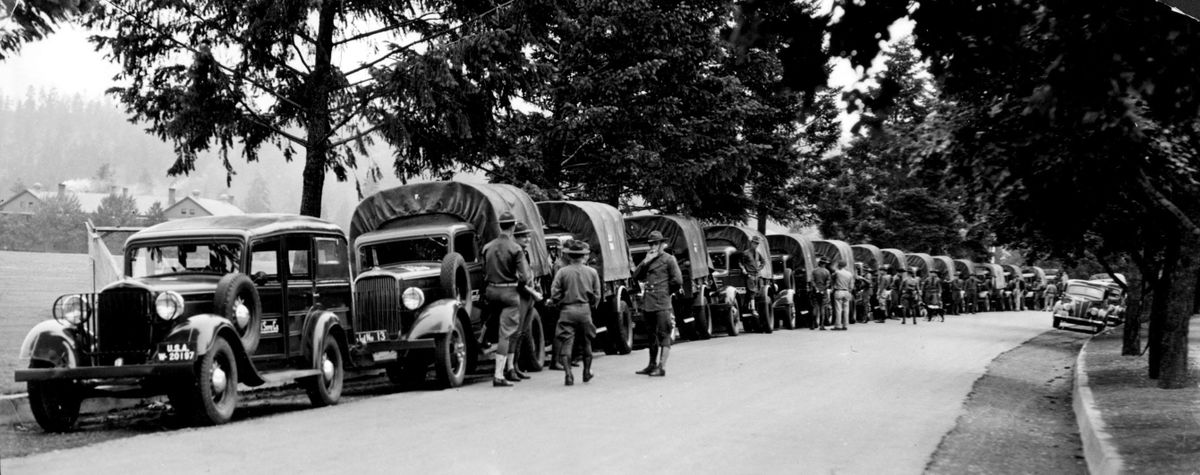Spokane Fourth of July celebrations started with humble gathering in 1874

Spokane’s first Fourth of July celebration in 1874 was a simple affair – no gunfire, no fireworks, but lots of Native Americans.
The city was called Spokane Falls back then, and James Glover, known as the father of Spokane, ran a store at the southwest corner of what is now Howard Street and Spokane Falls Boulevard.
He and a partner set the stage for the first celebration by building a stage and dance floor.
As Glover told it later, people came from as far as 50 or 60 miles away and spent three days camping near the river. They fed on the abundant trout they caught.
On the Fourth, there was food and speech-making followed by dancing.
After the settlers ate, they gave the leftovers to the Native Americans. And when the settlers were done dancing, the Native Americans took to the floor with their own celebratory customs.
Independence Day was a relatively small community event in the early years, but it gained notoriety after the centennial in 1876. Settlers arriving from the north were ferried across the river by Native Americans in dugout canoes.
In the years since, the Fourth of July has been a reflection of both the local and the national culture.
“It was a huge deal,” said historian Jim Price, a former Spokesman-Review staffer. “Everybody celebrated.”
Those early celebrations had a pattern: picnic, parade, speeches and baseball. Later, horse racing and wagering were added, along with explosives. Native Americans competed in the races, Price said.
During the centennial in 1876, nearly 400 settlers came to Spokane, where gunfire and music made the day. They feasted from a barbecue pit.
Two years later, the barbecue was a whole ox.
In 1881, Glover was feted as parade marshal. A 13-gun salute signaled the parade start. The speaker that day shot off “Chinese fireworks” and presented a keg of beer, according a newspaper story.
The raucousness increased as the celebrations grew more elaborate.
In 1884, a crowd of what one newspaper writer called “tatterdamilions” marched throughout the town. The “king of electric light” was nearly burned to death when a firecracker touched off his mock robes.
Famed hotelier Dutch Jake Goetz brought his cannon to the fun and staged a mock Revolutionary battle in 1889, about a month before Spokane’s Great Fire swept through downtown.
But much of the celebration moved to what became known as Natatorium Park on the Spokane River at the western foot of Boone Avenue.
A wave of patriotism sparked by the Spanish-American War in 1898 left its mark on the Fourth of July as well, creating a heightened sense of nationalism.
But the biggest change over the years arrived around 1910 when automobile and rail travel became common.
The City Council that year banned “dangerous explosives.”
A Spokesman-Review article said on the Fourth that the Washington Water Power Co. trolleys had 100,000 paid fares that day. Hillyard had a big party, and trolleys ran every five minutes. Natatorium Park got 8,000 visitors.
Thousands of people left the city for places like Hayden and Liberty lakes and Coeur d’Alene.
A roundtrip commuter rail ride to Liberty Lake was 60 cents; Coeur d’Alene cost $1.
The pattern of going to the lake persists today.
“For most people, it was a family event,” Price said of the long-ago celebrations.
During Expo ’74, there were at least six major events, all of which drew large crowds.
A “pro-pot smoke-in” at High Bridge Park came under criticism afterward by City Council members.
A concert at Albi Stadium was so large that an overflow crowd was left outside.
Russian gymnast Olga Korbut once appeared at the Spokane Coliseum.
An event called Neighbor Days held reign in Riverfront Park for 19 years but folded in 1996. The Clear Channel radio station group picked up the celebration through 2007, which was the year that 17 protesters were arrested for a raucous demonstration against police force.
The city parks department took over the celebration since then, maintaining the tradition of fireworks over the river.
Spokane banned all fireworks in 1993 after years of carnage. More than 460 fires were attributed to fireworks from 1988 through 1992. Still, the availability of fireworks outside of Spokane has continued to tempt revelers.
Some of the most charming aspects of July Fourth have persisted through the years.
Paul Mann, a leading preservationist in Spokane who traces his family history in America to the 1600s, said his Cliff Park neighborhood has had its own parade every year. It’s kind of a throwback to the old days.
“It’s been going on for years,” he said.
Crowds gather along Cliff Drive to view the downtown fireworks show.
“Inevitably, there is someone firing” some kind of fireworks, he said.